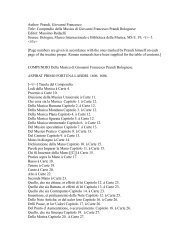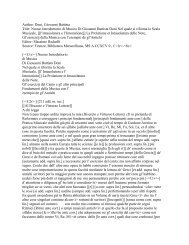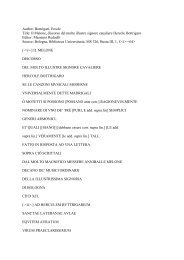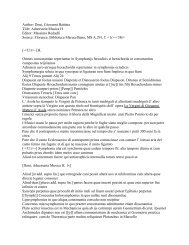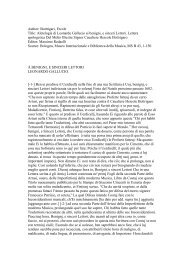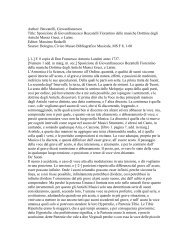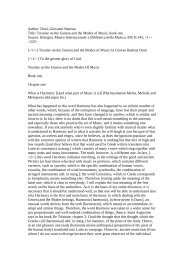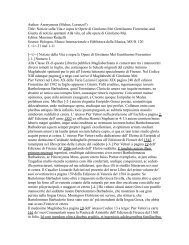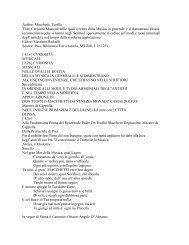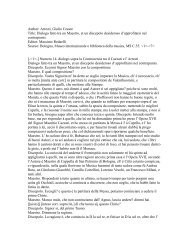Author: Dentice, Luigi - manuscripts of italian music theory in ...
Author: Dentice, Luigi - manuscripts of italian music theory in ...
Author: Dentice, Luigi - manuscripts of italian music theory in ...
Create successful ePaper yourself
Turn your PDF publications into a flip-book with our unique Google optimized e-Paper software.
ema<strong>in</strong><strong>in</strong>g proportions, which are either varied or not very clear or at a great distance one<br />
from the other, produce the dissonances.<br />
Serone. You are right, but do let us return to the demonstration <strong>of</strong> whether the<br />
diapasondiatessaron is a consonance.<br />
Soardo. Let us do so. You must know two notes considered jo<strong>in</strong>tly can be dissonant,<br />
consonant, <strong>in</strong> unison, aequisonant or emmeles. The ones that are dissonant are the ones<br />
that do not agree at all, the consonant are the fifth, the twelve, the n<strong>in</strong>eteenth and the other<br />
compounded ones. The emmeles are the one that can be adapted to a melody or that can<br />
be <strong>in</strong>terspersed among the perfect consonances, namely, the thirds, sixths and all the<br />
others. Now, the Pythagoreans say that consonances place on top <strong>of</strong> other consonances<br />
produce other consonances, because the diapente and the diatessaron added together<br />
produce the diapason. [-f.13r-] Also, if one adds the diapente to a diapason, the result will<br />
be a consonance, whose name will derive from the name <strong>of</strong> both consonances and will be<br />
diapason diapente. Equally, if a diatessaron is added, the Bisdiapason will be created,<br />
represented by the quadrupla proportion. So, what will happen if we add the diatessaron<br />
and the diapason together Accord<strong>in</strong>g to the Pythagoreans, they will not produce any<br />
consonance, because this falls <strong>in</strong> the superpartiens genus <strong>of</strong> <strong>in</strong>equality and it does not<br />
preserve the order <strong>of</strong> the multiplix genus <strong>of</strong> the simplicity <strong>of</strong> the superparticular. Now, let<br />
us lay out the numbers <strong>in</strong> order that this may be observed more easily. Take the number<br />
three, <strong>of</strong> which six is double or correspond<strong>in</strong>g to the ratio <strong>of</strong> the diapason. Add to it the<br />
sesquitertia, namely, the number eight, which we have said to be the diatessaron, which is<br />
also <strong>in</strong> the proportion <strong>of</strong> the diatessaron with the number six. If we compare the number<br />
eight to the number three, the number eight will conta<strong>in</strong> it twice, but as it is not its<br />
multiple, will conta<strong>in</strong> some parts <strong>of</strong> it, with are also not simple, because it exceeds it by<br />
two units, which are two thirds <strong>of</strong> the number three, which we place as the first and<br />
smallest term. Therefore, lay out the terms <strong>in</strong> this way iii vi viij, and you will see that the<br />
one that falls between two consonances next to it it is not a whole double, so that it may<br />
represent the diapason, nor it is triple, so that it represents the diapasondiapente. If a tone<br />
is added to it, the triple mode <strong>of</strong> the proportion will be created because the diapason and<br />
the dipente together correspond to the triple and the the diatessaron and the one tone to<br />
the diapente. However, if the diatessaron is added to the diapason, it will produce<br />
certa<strong>in</strong>ly a dissonant <strong>in</strong>terval, because one cannot observe naturally a proportion <strong>of</strong><br />
multiplicity between double and triple, and if to that one adds one tone, the result is the<br />
diapasondiatessaron and one tone. One might say that this [-f.13v-] corresponds to the<br />
diapasondiapente, because the diatessaron and one tone constitute the diapente. Now, if<br />
the Diapason is iii and vi, the Diatessaron vi and viiiand the diapente iii and viiij, the<br />
tripla proportion will be iii vi viij viiii. However, although Nichomacus many<br />
observations about this, nevertheless I have demonstrated (partly because <strong>of</strong> the very<br />
op<strong>in</strong>ions <strong>of</strong> the Pythagoreans, and partly deriv<strong>in</strong>g some <strong>of</strong> my arguments from them) that<br />
if the diatessaron is added to the diapason, the result is not at all a consonance.<br />
Serone. Therefore the consonance <strong>of</strong> the diapason is represented by the dupla, as i and ij,<br />
the diapente by the numbers 2 and 3, the diatessaron by the proportion 3 et 4, the tone,<br />
which does not conta<strong>in</strong> a consonance, <strong>in</strong> the numbers 8 and 9, the diapason with the<br />
diapente is reduced to the proportion <strong>of</strong> the tripla, such as 2 4 6, the bisdiapason <strong>of</strong> the<br />
quadrupla, or 2 4 8, while the diatessaron jo<strong>in</strong>ed with the diapente produces a diapason<br />
represented by this proportion 2 3 4.<br />
Soardo. You understand it well, because, if a note is <strong>in</strong> dupla proportion with another one<br />
upwards or downwards, the result is a diapason, if it is <strong>in</strong> sesquialtera, sesquitertia or<br />
sesquiottava proportion upwards or downwards, the result is, respectively, the <strong>in</strong>terval <strong>of</strong><br />
the diapente, <strong>of</strong> the diatessaron and the tone. Also, if one adds the sesquialtera and the


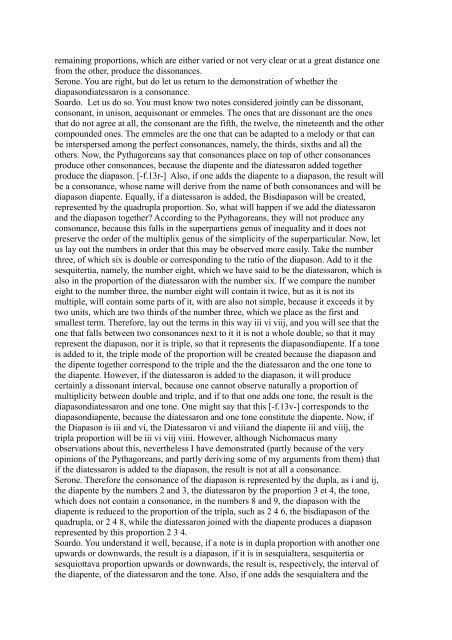
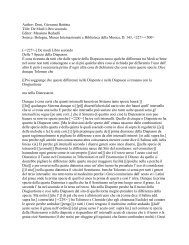
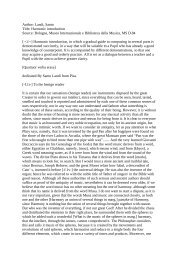
![Doni, Giovanni Battista Title: Trattato Dei Tuoni o [[Harmonie de]]](https://img.yumpu.com/45461005/1/190x245/doni-giovanni-battista-title-trattato-dei-tuoni-o-harmonie-de.jpg?quality=85)
